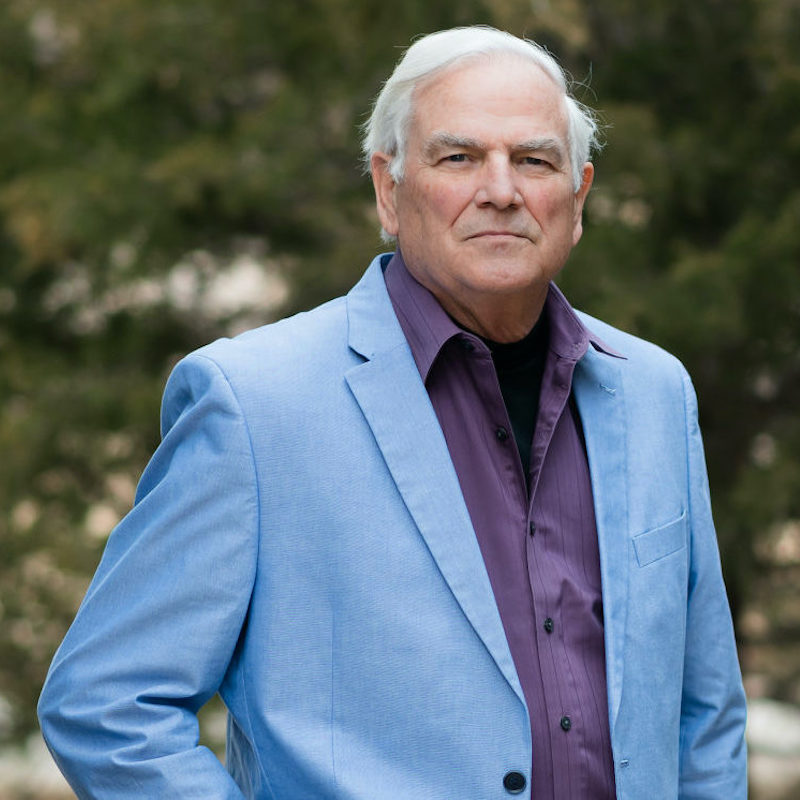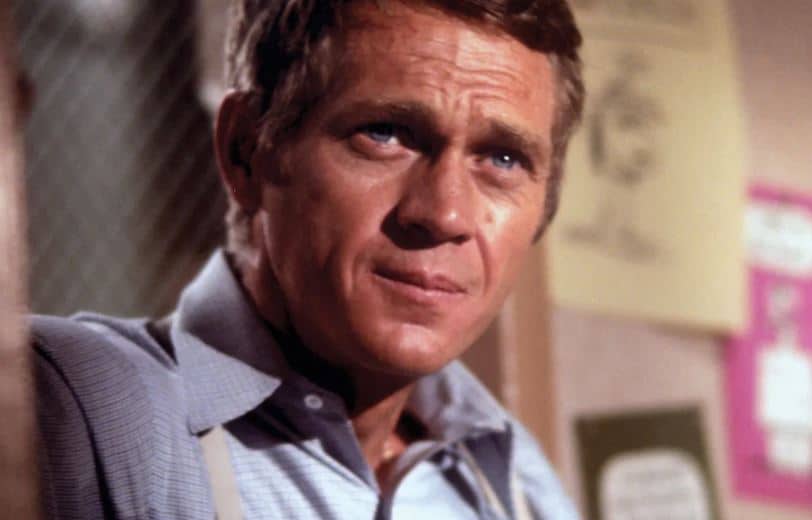This week’s Hearing International features the legendary Steve McQueen – the “King of Cool” as he was known in his heyday in the 1960s and 70s. His tumultuous childhood from very meager beginnings and his hearing loss shaped his life and relationships with others, including those closest to him.
With his blond hair, blazing blue eyes and chiseled features, his face was more eloquent than any of the lines written for him in his most famous hit movies, The Great Escape (1963), Bullitt (1968), Getaway (1972) and The Thomas Crown Affair (1968). Who could ever forget the chase scene from Bullitt between a ’68 Dodge Charger and a ’68 Mustang through the streets of San Francisco? He made 27 films, beginning with a bit part in “Somebody up There Likes Me” (1956) about the life of the boxer Rocky Marciano. His big break came in 1958 with a rather strange, inauspicious debut in a leading role with the movie “The Blob” (1958), playing Steve Andrews, an innocent young guy on lovers lane with his girlfriend, who battles a slimy space invader that comes to earth in a meteor decimating and terrorizing a rural town in Pennsylvania. While not exactly the King of Cool debut, it got him noticed for television for a very successful television series, the 1958-61 CBS series “Wanted: Dead or Alive”. McQueen later became one of the few early ’60s TV stars to successfully make the transfer back to a career in motion pictures. He had a raw yet gentle air that appealed to both male and female movie goers as a romantic hero and an adventurer. McQueen fans like to believe that he was uncompromisingly macho, yet with a gentle heart. Not exactly Steve McQueen the real person.
A Hearing-Impaired Recluse
Steve McQueen, the iconic actor known for his captivating performances on the silver screen, was also a figure of intrigue and complexity in his personal life. Despite his fame, he led a reclusive existence, avoiding parties, social gatherings, and situations that required extensive communication and interaction. The reasons behind his behavior can be traced back to his tumultuous childhood, marked by abandonment, abuse, and a series of challenging circumstances.
Born on March 24, 1930, to a teenage prostitute named Jillian Crawford, McQueen never knew his biological father, Terrance McQueen, who worked as a stuntman for a flying circus. Terrance abandoned his mother just six months after their initial encounter. At the age of three, Steve’s mother left him to live on a Missouri farm with a great-uncle for extended periods while she wandered the streets of Los Angeles. She would occasionally return and take him back temporarily, only to send him back to the farm again. By the time he reached nine years old, he was subjected to severe beatings from his mother’s new husband, which forced him to seek refuge by sleeping on the streets of Los Angeles.
McQueen’s journey took him through various hardships, as he ran away to join a traveling circus and later became involved with a street gang upon returning to the city. At the age of 14, he was caught stealing hubcaps, leading to an 18-month sentence at the Boy’s Republic reform school. He credited this experience with turning his life around and later supported the school anonymously with financial contributions and donations. By the age of 16, he found work as a “towel boy” in a brothel, where he was encouraged to indulge in its offerings.
A Passion for Cars and Motorcycles
In 1947, McQueen enlisted in the Marine Corps and was stationed at Camp Lejeune, North Carolina. There, he worked as a tank driver and mechanic, which fostered his lifelong passion for vehicles, particularly motorcycles. During his three-year tenure in the Marines, McQueen demonstrated bravery and heroism by rescuing five Marines from a training accident, earning him a commendation. After completing his service, he struggled to make ends meet, surviving on menial jobs and resorting to shoplifting. It was a friend who suggested he pursue acting school, seeing it as an opportunity to meet attractive women. Taking advantage of the GI Bill education benefits in 1952, McQueen enrolled at the Actors’ Studio in New York City. Over the next six years, he honed his craft and emerged as a temperamental yet highly successful actor, enjoying notable achievements in both television and movies.
However, McQueen’s life was not only defined by his professional accomplishments. It was a tapestry woven with torrid marriages, encounters with notorious figures like Charles Manson, a passion for motorcycle racing, an affinity for conceal and carry guns and target practice, a deep love for his children, and a mysterious death in a Mexican cancer clinic on November 7, 1980. But amidst these tales lies a lesser-known aspect of his life—his hearing impairment.
Lifetime Struggle with Hearing Loss
Since the age of six, McQueen had been “deaf” in his left ear, the result of latent stages of otitis media—a middle ear infection. The infection progressed into mastoiditis, a condition where the infection spreads to the mastoid bone of the skull. The mastoid bone, filled with air cells, can deteriorate when infected, potentially leading to permanent hearing loss. In the 1930s, when McQueen was growing up, antibiotics were not yet widely available, and surgery was the primary treatment option. Mastoidectomy, the removal of part of the bone to drain the mastoid, was a common procedure performed on children during that era. Additionally, myringotomy, a surgical procedure to drain the middle ear through the eardrum, was also commonly performed. However, given the neglect McQueen experienced during his childhood, it is safe to assume that he did not have access to these treatment options.
The complications of untreated mastoiditis can result in sensorineural hearing loss, tinnitus, and even vertigo that can last for days. Furthermore, evidence suggests that McQueen ruptured his left eardrum while scuba diving at the age of 20, exacerbating his hearing difficulties in that ear. Considering these factors alongside the residual effects of mastoiditis, it is likely that he experienced significant conductive hearing loss in his left ear, which may have progressed to some degree of sensorineural hearing loss over time. Audiologists would deduce from his hearing history that a hearing loss of 40-60 dBHL could be expected, with a better prognosis for high frequencies.
Throughout most of McQueen’s life, noise exposure was not widely recognized as a hazard to hearing health. While the conductive hearing loss in his left ear offered some protection, his right ear was susceptible to the detrimental effects of exposure to noise from activities such as shooting, driving automobiles and motorcycles, all of which are known to cause high-frequency sensorineural hearing loss. Consequently, it is reasonable to assume that McQueen may have experienced some degree of high-frequency hearing loss in his right ear.
The consequences of McQueen’s hearing impairment were not limited to audiological challenges. It likely affected his ability to comprehend women’s speech, particularly in noisy situations and when attempting to listen from a distance. This difficulty in understanding high-frequency voices, combined with the demands of his career, could have contributed to misunderstandings and frustrations both on movie sets and in his personal relationships. Considering his tumultuous history and his reclusive behavior, it is plausible to suggest that his hearing loss played a significant role in shaping his overall behavior and interactions with others.
In understanding the life and legacy of Steve McQueen, it is essential to delve beyond his on-screen persona and explore the multifaceted aspects that influenced his personal journey. His troubled childhood, marked by neglect and abuse, coupled with his hearing impairment, shed light on the challenges he faced and the reasons behind his reclusive nature. Through his enduring performances and the enigma surrounding his life, McQueen remains an icon of the silver screen, forever etched in the annals of Hollywood history.
It is likely that he did not understand the speech of women, particularly from the left and in noisy situations and this issue would have been worse when trying to listen from a distance. Childhood notwithstanding, some of his overt behaviors on movie sets and in relationships could have been due to the hearing loss. This could have contributed to the torrid relationships with women, who have high frequency voices that would have been more difficult to understand, and other people in his life. The hearing loss, high frequency voices, distance hearing often through noise could have led to misunderstandings at home and created some frustration on movie sets. Considering the history and his reclusive behavior as well as communication in his close relationships, it is possible that this hearing loss may have contributed substantially to his overall behavior.
With his checkered childhood still fresh in his memory at age 33; Mr. McQueen wrote: “When I did ‘The Great Escape,’ I kept thinking, if they were making a movie of my life, that’s what they’d call it – the great escape.”
References:
- Ebert, R. (1980). Remembering Steve McQueen. The Interview. Retrieved February 6, 2017.
- Honan, C. (2011). The heart throb who hated women: wife beater, drug taker and relentless
- philanderer, the brutal truth about Steve McQueen.
- Lampert, N., (2014). Why my dad was cinema’s Mr. Mean by Steve McQueen’s son. Daily Mail. Retrieved February 6, 2017.
*Featured image: Steve McQueen in Bullitt (1968). © Warner Brothers/Seven Arts
About the author

Robert M. Traynor, Ed.D., is a hearing industry consultant, trainer, professor, conference speaker, practice manager and author. He has decades of experience teaching courses and training clinicians within the field of audiology with specific emphasis in hearing and tinnitus rehabilitation. He serves as Adjunct Faculty in Audiology at the University of Florida, University of Northern Colorado, University of Colorado and The University of Arkansas for Medical Sciences.
**this piece has been updated for clarity. It originally published on February 6, 2017







